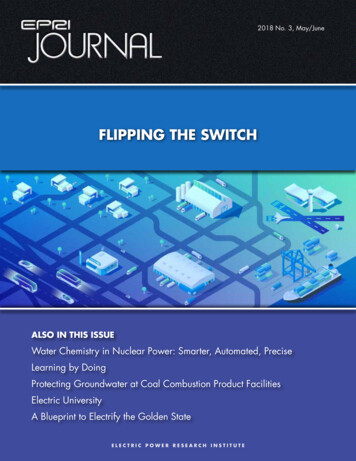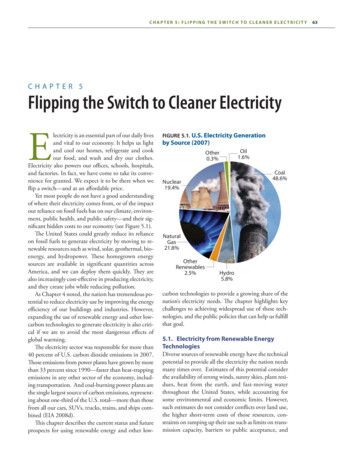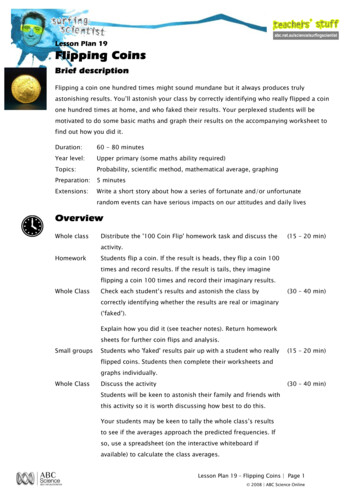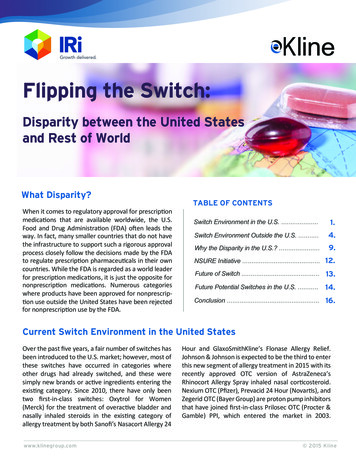
Transcription
2018 No. 3, May/JuneFLIPPING THE SWITCHALSO IN THIS ISSUEWater Chemistry in Nuclear Power: Smarter, Automated, PreciseLearning by DoingProtecting Groundwater at Coal Combustion Product FacilitiesElectric UniversityA Blueprint to Electrify the Golden StateELECTRIC POWER RESEARCH INSTITUTE
EPRI JOURNALMay/June 2018 No. 3 1Table of ContentsFlipping the Switch .2Learning by Doing .7Water Chemistry in Nuclear Power: Smarter, Automated, Precise . 11Protecting Groundwater at Coal Combustion Product Facilities . 17Viewpoint—Electrification: The Conversation Is Changing . 23First Person—A Blueprint to Electrify the Golden State. 25First Person—Electric University . 31Solar Storm Preparedness . 38EPRI Takes the Lead at Incubatenergy . 40Helping Grid Components “Fail Gracefully” . 42Data-Driven Insights for Electricity Customers. 44Miniature Monitoring . 46Solar for the Long Haul . 49EPRI Demonstrates Laser Sensors to Optimize Coal Plant Combustion. 51From Refrigerators to Hot Dog Rollers: Making Convenience Stores More Efficient . 52Street Lights: Not Just for Lighting Anymore. 53The Key to Success with Drones for Environmental Applications: Diligence . 54Solar Module Recyclers: On a Mission to Recover More Materials with Less Energy . 55www.eprijournal.com
EPRI JOURNALMay/June 2018 No. 3 2Flipping the SwitchNew EPRI Initiative Aims to Unleash Electrification’s Enormous Potential Benefits forSocietyBy Chris WarrenAs the United States prepared to enter World War I in 1917, most American households, including the wealthyones, lacked running water and a telephone. What happened in the ensuing 100 years to transform elusiveluxuries into basic necessities? A big part of the answer: widespread availability of electricity and steadilyadvancing end-use technologies to harness its power.“As we improved the quality of life in the American home through technology, we have increased electricityuse,” said Mark Duvall, director of energy utilization at EPRI. “In the kitchen, refrigerators replaced iceboxes andelectric stoves replaced wood-fired stoves. We added appliances, TVs, and other connected loads that made thehouse a cleaner, more comfortable place to live.”Today, new momentum is building for electrification to extend its reach and its benefits. In the residential,commercial, industrial, and transportation sectors, customers are switching technologies such as automobiles,forklifts, and furnaces from direct combustion of fossil fuels to electricity. The switch to electric vehicles (EV)illustrates benefits that are common across the board.“If I buy a vehicle with an internal combustion engine today and drive it for 11 years, society will never realizeany air quality or carbon improvements during that period,” said Rob Chapman, vice president of EPRI’s Energyand Environment Sector. “Compare that with a vehicle powered by the electric grid. Since 2000, the electricpower sector has reduced emissions of criteria air pollutants by 80% and carbon dioxide by 20%. If we continueto ‘green’ the electric supply and make the grid more dynamic and flexible, EVs get cleaner the longer you havethem.”www.eprijournal.com
EPRI JOURNALMay/June 2018 No. 3 3Click here to enter this interactive graphic about electrification.Even as society’s energy appetite grows, electrification points to new, diverse uses and benefits. EPRI estimatesthat Southern Company avoided approximately 5,000 tons of nitrogen oxide, sulfur oxide, and carbon dioxideemissions by choosing electric equipment instead of diesel to dredge at the Port of Mobile, Alabama.Often, the most significant challenge to lower bills and a cleaner environment is that utility customers don’tknow what’s possible with electrification. With support from EPRI, utilities have added a new component totheir customer engagement strategies—identifying electric technologies that could save money for commercialand residential customers and educating them about these and other benefits.www.eprijournal.com
EPRI JOURNALMay/June 2018 No. 3 4The Efficient Electrification InitiativeAccording to the U.S. Energy Information Administration, today about one-fifth of America’s final energyconsumption is electricity, with the rest coming from direct combustion of fossil fuels such as coal, natural gas,and petroleum. The U.S. Department of Energy has chronicled how the burning of fossil fuels has provided morethan 80% of the nation’s energy for the past 100 years, enabling the first wave of electrification that providedrunning water, lit up homes, and switched on radios and TVs.EPRI’s wide-ranging Efficient Electrification Initiative aims to describe and enable the economic, environmental,productivity, and other improvements that individuals and society can realize through electrification usingadvanced power systems and end-use technologies. Launched in 2017, the initiative takes an in-depth, factbased look at the benefits and costs of far greater electrification, analyzing scenarios in which up to 50% ofenergy end use comes from electricity by 2050. Participants include utilities, policymakers, regulators,manufacturers, consumers, and other energy sectors.EPRI spearheaded the initiative as an extension of its Integrated Energy Network, which describes a future withan integrated “system of systems” for electricity, water, natural gas, and transportation, along with a pathway toget there. The Integrated Energy Network encourages collaborative, innovative thinking to tackle the challengeof delivering cleaner, affordable, reliable energy to a global population expected to reach 10 billion by the end ofthe century. Efficient electrification will be instrumental in achieving this.Drivers: Cleaner Grid, Advancing Technology, CustomersAs innovative electric technologies are adopted along with significantly improved traditional technologies, thetime is right for a closer examination of widespread electrification. Again, EVs are instructive. To becomemainstream, electric cars, trucks, and buses need affordable batteries that enable significant driving range—andan enormous scope of research focuses on this. EPRI projects that EVs will reach price parity with internalcombustion vehicles within the next five years.As the penetration of natural gas and renewable energy technologies grows, the electric supply’s carbonfootprint declines. Also, the grid is becoming more efficient through the interconnection of advanced sensors,automation, and communication devices.“There will be as much technological change in the next seven years as what occurred over the past 30 years,”said Chapman. “These advances will occur in electric supply, grid, and end-use technologies. A more dynamic,flexible grid will help tap the potential of these technologies.”Electrification also is growing as a result of policy and corporate trends. Currently, U.S. cities and states havemaintained or deepened their commitments to reduce greenhouse gas emissions and deploy renewable energy.California’s 2030 targets include 50% of electricity from renewable sources and a 40% reduction in greenhousegas emissions. To help achieve carbon reductions and improve air quality, the state is looking at cross-sectorsolutions that include transportation electrification. Large companies such as Google, IKEA, and Walmart havecommitted to procure a large portion (in some cases, 100%) of their energy from renewables.Customer attitudes and priorities also propel EPRI’s initiative, even as they choose from expanding options inrooftop solar, EVs, smart thermostats, and numerous other end-use technologies.“Residential customers want options, flexibility, and the ability to manage and control energy expenses,” saidChapman. “Commercial and industrial customers want these as well, and they recognize that energy flexibilitycan translate into greater affordability, productivity, and safety.”www.eprijournal.com
EPRI JOURNALMay/June 2018 No. 3 5A Focus on Analytics, Technology, and R&D CollaborationAnalytics encompasses modeling, simulation, and other data analyses to quantify the implications of widespreadelectrification.“If you’re talking about how electrification benefits the consumer and society and leads to a cleanerenvironment and more affordable energy, you can’t say that without the analytics to support it,” said Chapman.“Our analytics team is looking at macroeconomic trends and scenarios for future carbon emissions tounderstand the impacts that increased electrification can have on air, water, and energy efficiency.”In April 2018, EPRI released its National Electrification Assessment examining societal, customer, and utilityimpacts of 50% electrification by 2050. The analysis is based on EPRI’s recently updated U.S. Regional Economy,Greenhouse Gas, and Energy (US-REGEN) model.“Over the past two years, we developed a very detailed model that equips us to track the consumption ofenergy by fuel and technology across the transportation, residential, commercial, and industrial sectors,” saidFrancisco de la Chesnaye, an EPRI senior program manager who is leading the analytical work. “The study’s keyfinding: Across a range of assumptions, economy-wide electrification leads to a significant reduction in energyconsumption, spurs steady electric load growth, increases grid efficiency and flexibility, and reduces greenhousegas emissions—even when there is no assumed climate policy.”In 2018, EPRI will begin similar assessments of the impacts of expanded electrification for states and utilityservice areas (see box at end of article).More widespread electrification depends on technological innovation. EPRI researchers collaborate withcompanies, national laboratories, and utilities to establish a pipeline of early-stage efficient electrificationtechnologies. As these technologies prove their potential in the laboratory, they are put in the field as part ofutility demonstration projects.“We are focused on the devices that utility customers own, such as EVs, energy-efficient appliances, zero netenergy houses, and energy storage,” said Duvall. “We’re accelerating our R&D in these areas and examiningtechnologies that aren’t being addressed currently.”New EV research includes an examination of consumer expectations regarding the availability of public fastcharging infrastructure. The results will help guide utilities, automakers, regulators, and policymakers as theymake investment decisions about the type and number of charging stations necessary to make consumerscomfortable purchasing EVs.Electrified indoor agriculture has the potential to move food production closer to consumers and cut water useby 95%.“Most areas of the country don’t grow their food year-round. Indoor agriculture could eliminate the land andclimate barriers—making it possible to grow tomatoes during a Wisconsin winter,” said Duvall. “Think of theenormous reduction in transportation costs and emissions if 50% of the produce for New York was grown within10 miles of the city. EPRI is monitoring demonstrations to validate environmental and productivity claims andbetter understand electricity demand.”EPRI is working with member utilities to identify how they can help residential and commercial customers reapthe benefits of electrification. Often, it’s a matter of pinpointing how a customer can benefit by adopting aspecific technology. In many cases, customers simply don’t know how and where electrification can save themmoney or reduce pollution.www.eprijournal.com
EPRI JOURNALMay/June 2018 No. 3 6“The Efficient Electrification Initiative can provide opportunities to educate customers more broadly tounderstand the costs, benefits, and obstacles to adoption,” said Duvall.In 2018, EPRI will develop an electrification R&D roadmap and begin an electrification cost-benefit assessment.In August 2018, EPRI will host an Electrification 2018 International Conference & Exposition in Long Beach,California—a forum for utilities, government agencies, nonprofits, and other energy companies to shareexperiences and insights and learn about EPRI research findings. This will become an annual gathering to sustainmomentum and chart a path forward. Stakeholders can identify avenues for collaboration, technologiesrequiring additional research, and policies that need to be formulated or reconsidered.“Let’s bring all the stakeholders together and make the research transparent,” said Chapman. “We provide ourunbiased research and facilitate the conversation. This is a key part of the initiative because so many people areinterested in the benefits of electrification relative to other forms of energy.”Dialing into State-Level ElectrificationEPRI’s recent National Electrification Assessment found that economy-wide electrification leads to a largereduction in energy consumption and greenhouse gas emissions as well as significant improvements in gridefficiency and flexibility.For a more detailed look at the opportunities and challenges, EPRI is using the U.S. Regional Economy,Greenhouse Gas, and Energy (US-REGEN) model for state- and utility-level electrification assessments. “Theresults of the national assessment serve as a starting point for our work at the state and utility level,” said EPRISenior Program Manager Francisco de la Chesnaye.The results will vary by state and utility service area. “Just as the electricity generation mix varies by state basedon fuel prices and energy and environmental policies, energy consumption also varies,” said de la Chesnaye.“Over the next 5, 10, or 15 years, these assessments can provide electric utilities, policymakers, and regulatorswith actionable insights on critical issues such as capacity expansion.”For example, de la Chesnaye points to the increase of electric vehicles that may result from a combination ofstate policies, consumer choice, and technology advances. When more electric vehicles are charged at night,state-level assessments can illustrate the potential impact across an energy system. “We can assess where thatenergy comes from,” he said. “How much will be from wind generation? Will baseload power plants have tocycle more, ramp up and down, or shut down? What are the implications for transmission?”Key EPRI Technical ExpertsMark Duvall, Francisco de la Chesnayewww.eprijournal.com
EPRI JOURNALMay/June 2018 No. 3 7Learning by DoingTwo-Plus Years of Integrated Grid Pilots Have Yielded Important LessonsBy Chris WarrenWhen EPRI launched the Integrated Grid initiative in 2014, it highlighted the need for a grid that integrates allresources, from large power plants to the smallest of distributed energy resources (DER). To help the industrymove toward a well-functioning integrated grid, EPRI researchers have emphasized the importance of hands-onexperience with solar photovoltaics (PV), energy storage, microgrids, and other technologies.“Demonstration projects with utilities are key opportunities to address gaps between theory andimplementation in advancing these technologies,” said EPRI Senior Project Engineer Steven Coley. Thisunderstanding prompted EPRI and its members to initiate more than two dozen Integrated Grid pilot projects inthe U.S. and internationally.More than two years of field work have yielded numerous lessons that will help guide future research and bestpractices for integrating DER. Here, we describe several insights, grouped according to the four-part action planin EPRI’s Integrated Grid concept paper.Interconnection Rules and Communications Technologies and StandardsIn an integrated grid, large numbers of solar panels, smart inverters, energy storage, and other technologiesneed to mesh seamlessly with utility operations. “Common languages and open protocols reduce the complexityof coordinating distributed resources,” said Coley. “But we are finding that there is limited deploymentexperience, and customized control configurations are used, so there is still a lot of room for improving andstreamlining the process.”Louisville Gas and Electric experienced a problem with its deployment of energy storage because its vendor’stechnology did not originally communicate properly with grid operations, and a unique system-control topologyhad to be developed and implemented. This type of case-specific fix underscores the need for morecoordination between utilities and DER vendors.www.eprijournal.com
EPRI JOURNALMay/June 2018 No. 3 8“Too often, customized solutions are needed to achieve suitable control of DER—an approach that is notstreamlined enough for broad deployment,” said Coley.Click here to enter this interactive graphic.EPRI has been heavily involved in the efforts of the IEEE Standards Association—in collaboration with DERvendors and developers, distribution and transmission utilities, researchers, and other public stakeholders—todevelop and revise the IEEE 1547 standard, which governs the interconnection of DER. The revised standard isexpected to take effect in 2018 and requires that DER have at least one means of open communication.“Most of our pilot projects have demonstrated the necessity of updated interconnection standards,” said Dr.Ben York, technical leader in EPRI’s Distributed Energy Resources program. “The standard’s development isbeing informed by our experience with the pilots.”Over the past four years, EPRI’s technical expertise and thought leadership have contributed to a successful,timely revision of the standard.“An example of this is EPRI’s 2015 white paper on low-voltage ride-through, which helped stakeholders on thestandard’s working group better understand this highly technical topic and reach consensus on newrequirements for this function,” said Dr. Jens Boemer, a senior technical leader in EPRI’s Grid Operations &Planning program. Adequate ride-through requirements for DER help to maintain power system reliability andkeep the lights on, even with extremely high levels of DER connected to the system.Because the previous version of IEEE 1547 lacked a common approach to communications and grid support, it isa challenge for utilities to communicate with DER installed on the distribution grid, leading to reducedawareness of grid conditions and potential system reliability risks.“Every time you connect a new inverter to the system, you have to learn a new language. It’s like having to learnFrench or Spanish every time you want to talk to a different inverter,” York said. “If you have 10 differentwww.eprijournal.com
EPRI JOURNALMay/June 2018 No. 3 9inverter manufacturers, you have to learn 10 different languages. What ends up happening is that utilities don’tcommunicate with any of them.”Through activities such as presentations at IEEE conferences and public utility commission hearings, EPRI plansto educate the industry and all interested stakeholders about the revisions to the IEEE 1547 standard as they arerolled out.“Our education is vital so that the standards are interpreted and implemented appropriately,” said Coley.Assessment and Deployment of Advanced Distribution and Reliability TechnologiesThe pilots are examining how several technologies perform in actual operating conditions on distributioncircuits. Confirming prior EPRI modeling work, the Arizona Public Service pilot demonstrated that smartinverters—by providing voltage support—can help address technical challenges that limit the safeinterconnection of solar power. The project also showed that allowing smart inverters to adapt certain functionsautonomously produced the most benefit to the grid. The inverters provided voltage support without noticeableimpact on solar energy production.“Even during hot Arizona summers, the temperature varies widely throughout the day. As air conditioningramps up, voltage support from inverters needs to adapt,” said York. “The Arizona Public Service project showedus that sizing your inverter even slightly larger than the amount of solar power that comes through it can createbig opportunities for grid support.”Strategies for Integrating DER with Grid Planning and OperationsPilots with Southern California Edison (SCE) and Hydro One are exploring how the sizing, location, and controlfunctions of distributed energy storage systems impact grid planning and operations.“EPRI is working with these utilities to develop a framework that can help them extract the most benefit fromthese resources,” said Coley. “We’re evaluating various scenarios, including one in which the utility controlswhere the storage is located and how it operates and another in which utility customers have all the control.”Both projects have shown that there are no simple answers about optimal location and operations of storage.Utilities must evaluate the trade-offs for each case. For example, locating storage near the end of a feeder nearload might significantly reduce capacity constraints, benefiting distribution grid operations.“However, if you want to maximize the value of the storage at the bulk transmission level, you may want tolocate it closer to the substation, where its output is not as constrained by the distribution feeder. This couldyield greater returns from interacting with the wholesale markets,” said Coley. “Utilities need to determinewhere the value is higher and assess capacity constraints in the distribution system. It can be difficult to balancethese considerations.”In Michigan and Indiana, American Electric Power connected four PV plants to its distribution grid and estimatedthat in one month of operation, snow on the panels reduced power generation from one of the four plants by20%. This finding has implications for how utilities interpret results from solar plant performance models andhow they account for snowfall—a known source of error.“The performance models estimated energy output to be plus or minus 5% of actual production. But in thesnowy winter months, energy generation can vary a lot more,” said Coley. “Utilities need to consider the realitythat snow can drastically affect performance and adjust their planning accordingly.”www.eprijournal.com
EPRI JOURNALMay/June 2018 No. 3 10Enabling Policy and RegulationWhile EPRI does not advocate for specific policies and regulatory frameworks, the pilot projects are designed toprovide policymakers with research and data to inform good decisions.“For each demonstration project, we are documenting costs, benefits, grid constraints, and other relevantinformation for policymakers,” said Coley. “We’re also demonstrating how the application of EPRI’s IntegratedGrid benefit-cost framework can inform policymakers and regulators.”The utilities WEC Energy Group and PECO are using the benefit-cost framework to evaluate proposedmicrogrids. In these microgrids, DER would serve local loads and provide electricity to communities whenweather or other emergencies disrupt transmission and distribution systems.“Through these feasibility studies, we learned that a clear understanding of the objectives for the specificmicrogrid application is important in finding the most value,” said Coley. “Each microgrid is different, and thereare many case-specific factors that drive what is and isn’t valuable.”The PECO study evaluated a utility-integrated, community microgrid that would deliver electricity to medicalcenters, shelters, a fire station, and other essential service providers during a utility outage. The study led toimportant insights on microgrid sizing and design, required distribution system reconfigurations, customerenergy use, costs, and benefits. PECO withdrew its regulatory filing on the project as a result of a lack ofstatutory clarity regarding ownership of some microgrid assets. Now, the utility is engaging with legislators andregulators to help establish a statutory and regulatory framework to guide microgrid development in the state.All these experiences and lessons are informing PECO as it embarks on a new microgrid project, with EPRIserving as a technical advisor.With funding support from New Energy and Industrial Technology Development Organization, Tokyo ElectricPower Company Holdings, Inc. (TEPCO) is conducting research to help integrate large amounts of PV in Japan.EPRI is providing technical support to TEPCO. “The initial focus was how the grid responds to excess solar andhow to manage that,” said York. “It has since morphed into understanding all the potential benefits of invertertechnology in managing solar energy.”One lesson is that the challenges and benefits of integrating solar into the distribution and bulk power gridsdepend on how much is interconnected. In some cases, modest amounts of solar can improve grid managementwhile larger amounts may pose grid management challenges.“We are learning about a lot of the technical issues that come from high levels of solar,” said York. “Internationalexperience helps everyone understand the role technology and policy can play in making DER integration assmooth as possible.”Key EPRI Technical ExpertsSteven Coley, Ben Yorkwww.eprijournal.com
EPRI JOURNALMay/June 2018 No. 3 11Water Chemistry in Nuclear Power: Smarter, Automated, PreciseField Demonstration Pursues Better Information with Fewer ResourcesBy Brent BarkerForty years ago, when many of the nuclear power plants in the United States began operating, plant waterchemistry was monitored by technicians who drew water samples manually, then walked them back to thelaboratory for analysis, trending, and recording. This occurred at regular intervals, ranging from every 4–6 hoursto once a day to once a week, depending on the parameter or chemical being measured.For the most part, it’s still done that way, relying onsignificant resources while providing infrequent datathat requires assumptions and informed guesses aboutconditions between measurements. Conservatism isbuilt into operational guidelines to help compensate foran incomplete picture of water chemistry.All that could change with EPRI’s Smart Chemistryinitiative, which has slated a major demonstration in2018. “If we can send a rover to Mars to pick upsamples, do chemical analysis, and beam the resultsback to Earth, we should be able to automate nuclearwater chemistry,” said EPRI Senior Program ManagerLisa Edwards. “We are on the verge of a new era inwater chemistry. Through automation and smartanalytics, we can provide better information with fewerresources and rethink our operational guidelines.”Chemicals That MatterIn nuclear plants, water chemistry programsmeasure dozens of parameters and chemicalconstituents that interact with each other and withplant materials. For example, plant chemists areconcerned about the levels of anions (such aschloride and sulfate) that can lead to cracking ofmajor components. Radioisotopes are trackedbecause they can indicate problems such as a leakin the fuel cladding. Corrosion products can impactheat transfer efficiency and, when activated, canexpose workers to radiation. Additives are alsomonitored and controlled. These include boron(which impacts the core’s reactivity), zinc (whichcan reduce corrosion products and radiation fields),and amines and alkalis (which help manage pH).www.eprijournal.com
EPRI JOURNALMay/June 2018 No. 3 12Smart Chemistry addresses the three main objectives of water chemistry control in nuclear power plants: Materials integrity—prevent degradation of the metals in the reactor pressure vessel, piping, steamgenerator, and other key components.Fuel reliability—optimize fuel performance and protect the fuel cladding.Worker safety—reduce radiation fields outside the reactor core.While the important constituents are currently monitored (see sidebar), the frequency of sampling remains anobstacle to more detailed knowledge of water chemistry. Consider two manual measurements of chemical Xtaken one week apart that are quite different—the first low, the second high. Which is more indicative of theplant’s chemistry? Is the first an outlier? Is the second a brief spike?“With nothing else to go on, we have to make the most conservative assumption that the level of chemical Xwas high the entire week,” said Joel McElrath, project manager of the Smart Chemistry Initiative. “If weincreased the frequency to hourly or daily, we’d have a much better pic
Flipping the Switch . New EPRI Initiative Aims to Unleash Electrification’s Enormous Potential Benefits for Society By Chris Warren As the United States prepared to enter World War I in 1917, most American households, including the wealthy ones, lacked running water and a telephone. Wh










